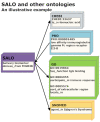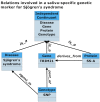Saliva Ontology: an ontology-based framework for a Salivaomics Knowledge Base
- PMID: 20525291
- PMCID: PMC2898059
- DOI: 10.1186/1471-2105-11-302
Saliva Ontology: an ontology-based framework for a Salivaomics Knowledge Base
Abstract
Background: The Salivaomics Knowledge Base (SKB) is designed to serve as a computational infrastructure that can permit global exploration and utilization of data and information relevant to salivaomics. SKB is created by aligning (1) the saliva biomarker discovery and validation resources at UCLA with (2) the ontology resources developed by the OBO (Open Biomedical Ontologies) Foundry, including a new Saliva Ontology (SALO).
Results: We define the Saliva Ontology (SALO; http://www.skb.ucla.edu/SALO/) as a consensus-based controlled vocabulary of terms and relations dedicated to the salivaomics domain and to saliva-related diagnostics following the principles of the OBO (Open Biomedical Ontologies) Foundry.
Conclusions: The Saliva Ontology is an ongoing exploratory initiative. The ontology will be used to facilitate salivaomics data retrieval and integration across multiple fields of research together with data analysis and data mining. The ontology will be tested through its ability to serve the annotation ('tagging') of a representative corpus of salivaomics research literature that is to be incorporated into the SKB.
Figures





References
-
- The NIDCR Expert Panels in long-term research agenda for the Period 2004-2009. http://www.nidcr.nih.gov/Research/ResearchPriorities/ExpertPanelsOnScien...
-
- Phillips C. Rinse and spit: saliva as a cancer biomarker source. NCI Cancer Bulletin. 2006. pp. 3–5.
-
- FY 2008 NIH Annual Performance Report. http://nihperformance.nih.gov/NR/rdonlyres/35C6BF35-688F-405E-94FE-E58BD...

